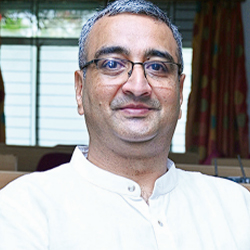new-dimensions of banking and finance

Nowadays, the Banking Sector in India is fast adopting technology to modernise the core banking solutions, while creating various digital offerings across products and services. Technology is changing the face of the Indian banking sector like never before. A dedicated and soft spoken banking professional, Amit Mahajan, Senior Vice-President, Digital Business and Transformation, Axis Bank, has a vast experience in banking and finance sector. He has also worked previously with GE Money Financial Services Ltd, ICICI Prudential Life Insurance, Infosys and so on. Dynamic and having a vast knowledge of banking, Amit Mahajan speaks to Corporate Citizen, of new development technologies and banking initiatives to provide quicker and hassle free banking service to the customers
"Every customer is unique and so are the requirements. The success of banks is and will be largely attributed to providing a bouquet of services and fulfilling them in the fastest and simpler manner for that very customer. Trust is the essence of banking and hence emphasis on information and data security will be the essence for any successful bank"
As the internet penetration keeps increasing, the awareness levels are increasing, the acceptance levels are increasing and for these very reasons, people are exploring
-Amit Mahajan
"Customer needs the convenience of banking at his doorstep irrespective of where his base branch is. A lot of thrust is convert the services digitally so that the customer can avail them from wherever he is. Be it a new account or a loan requirement or a cheque book or statement request, all these can be done digitally and as such the “Bank moves along with you – in your pocket”"
Corporate Citizen: On what does the success of a private bank depend upon, especially in India?
Amit Mahajan:Let us understand why does a bank exist? Bank exists because of its customers. Every customer is unique and so are the requirements. The success of banks is and will be largely attributed to providing a bouquet of services and fulfiling them in the fastest and simpler manner for that very customer. Solutions should be built and offered with the key factors of simplicity, agility, ease of execution and needless to say within the regulatory framework. Trust is the essence of banking and hence emphasis on information and data security will be the essence for any successful bank.
CC: Credit cards were good and then came the Unified Payments Interface(UPI). Will the credit aspects continue while other modes of payments are evolving?

Today, the good news is the regulator is looking at a road map involving more tech innovations. This serves as a great opportunity to define, create and take to market new services, which for sure are and will continue to create disruptions. What was good today may be redundant tomorrow, hence the key is to evolve. With thrust on digital transactions and ecomm building up, digital payment structures such as credit card and UPI are here to stay. UPI as a structure is being accepted internationally. Digital Money is another product being released by banks and I am sure the adoption will be fast.
Like I said, we need to be in the space everywhere where the customer needs us. Credit cards, UPI etc. will continue and will be part of a bouquet of offerings that a customer can select and choose as per their convenience.
CC: What are the key focus areas of today’s banks, as far as the digitisation of banking functions are concerned?
Digitisation and Digital Banking has to be looked at a bit differently. Digitisation is more of leveraging tech to automate processes while digital banking is all about building products and services which have limited if not nil manual intervention. Digital Banking comes with certain risks and hence the focus is to build sound products, offer services that are in line with what the customers ask, with a strong info security layer and in accordance with the regulatory framework. Apart from this, customer awareness is critical to ensure safety and confidentiality of his money
CC: The UPI market is evolving. How do you feel the UPI market will continue to grow?
UPIs have made life simpler for the person. Even if you go to the tier-4 cities, people are using Google Pay, PhonePe or UPI. The penetration rate is far higher than what you and me think. This is largely attributed to the internet revolution with deeper penetration leading to more products being accessed digitally by the very last mile customer. The next wave we foresee will be the digital money and digital rupee, which is going to come and help not only the government but also the person on the ground.
CC: Smartphone penetration is increasing in the country and they have reached the villages too. So the usage of internet and its services has begun in the villages. How will it help the banking and other sectors?
Reliance Jio has revolutionised the entire internet space and mobile space. Today, we are one of the fastest growing economies with high growth in internet accessibility. As the internet penetration keeps increasing, the awareness levels are increasing, the acceptance levels are increasing and for these very reasons, people are exploring. In the same breath one has to be cautious of not falling for any phishing scams etc. Banks have also set up a rural market focused division—Bharat Banking to capitalise on this very market and ecomm players are looking at this market segment as the next wave of growth.
CC: Banks are allowing the employees to bring their own devices to the bank and work on them. How does it work and are there any security concerns regarding the same?
Covid-19 gave a new dimension to the way of working. While few of the banks had implemented the bring-your-own-device concept, the period from 2022 redefined the same with greater access and higher security norms implemented. Today, this is a new normal—employees can access emails and other applications under the stringent framework of securities and guidelines which have been robustly built and implemented with periodic updations.
InfoSec teams continuously monitor security related interventions ensuring employees can now work from anywhere and everywhere as long as there is an internet connection.
CC: Banks are now setting up large dedicated in-house digital team. How is this evolving?

their digital structures build and maintenance—a combination of in-house, outsource and partnership irrespective of the approach of bank’s IT team ensuring the development and maintenance within the risk frameworks of the bank. Engagement with fintech partners is on the rise as the point is, why spend too much on creating something when it is available already. This symbiotic relation kind of helps each other to co-create or build certain products with a faster go to market. Banks are now leveraging cloud infrastructure from a scalability perspective.
CC: How are banks leveraging the cloud services to create new business frontiers?
Infra maintenance, upgrade, space availability etc., comes with its own challenges. The regulator has allowed banks to leverage the cloud and all banks are now moving from a physical to cloud infra
CC: An example of how banks are coming out with innovative ideas to resonate with customers. Such as your video for receiving KYC details from customers.
Again Covid pandemic forced to rethink the way we work. Thanks to the regulator and evolving technology, a customer sitting at the comfort of his home can now open a savings or a current account and start transacting in a couple of hours, just like any bank account. The challenge always remains is to offer personalised services as against a commoditised product and therefore there is a lot of thrust on customer life cycle management to ensure the customer and banks remain highly engaged with each other.
CC: Banks are collaborating with some fintechs. So how does this help the bank and its customers?
Fintechs are the new age things. They think differently than the traditional way of working and for sure keep the solutions simple. Banks within the clause of their risk framework and Reserve Bank of India (RBI) guidelines, work across fintechs to build and co-create products. We continue to learn from each other every day. Fintechs and emerging NBFC’s are looking at banking partnership to scale up, while banks are looking at fintechs from a new age offering perspective.
CC: Mobile banking is now more used than internet banking. What is the reason behind it and do you feel it will increase further in future?
A bank needs to be available to the customer at the place and time of his choice. Therefore, apart from the physical branches there is a lot of emphasis on multiple digital properties that can give an omnichannel experience to a customer. Focus is to self-enable and empower the customers on one hand while personalising the digital offerings. Mobile being an integral part of our lifestyle, mobile banking will continue to grow as the “Bank in your pocket” is available to anyone 24x7 for their queries, transactions and services.
CC: What is, ‘Branch of the Future’?
Jobs and business spreads are increasingly making us travel locally and globally. Customer needs the convenience of banking at his/her doorstep, irrespective of where their base branch is. A lot of thrust is to convert the services digitally so that the customer can avail them from wherever they are. Be it a new account or a loan requirement or a cheque book or statement request, all these can be done digitally and as such the “Bank moves along with you, in your pocket”
CC: Any new things that are planned for the future of banking space?
Banking sector is evolving at a fast pace. What was good yesterday, is not good today. What is good today might not be good tomorrow. So one has to keep on innovating. One has to keep on evolving. If we are aware of what has to be created, then we develop it. If we are not aware then we piggyback or partner with certain fintechs or we start creating certain ideas with certain new fintechs and leverage that product. Like I said, solutions will keep developing, services will become simpler but the way I look at it, a lot of focus will be towards personalising and hyper personalising the services for that very customer